Modern camouflage: the principles of creation, species, prospects. 1 part
Modern camouflage: the principles of creation, species, prospects
Part of 1. General principles. Russian camouflage
On the supply of almost all modern armies is uniforms, designed to be used directly on the battlefield - field uniform. Most of the world's armies have this uniform camouflaged. This material provides an overview of the main camouflage colors currently used in various armies of the world.
It should also be noted that this material does not cover the themes of cutting uniform, the quality characteristics of the fabric, and similar issues. The subject of consideration is exclusively the textural and color scheme used in camouflage.
At once I will make a reservation that in the material not all are considered, but only the main and most common camouflage; the theme of camouflage 1940's and earlier camouflage (of which there were quite a lot) is also not disclosed; the theme of special (for example, urban, “hunting” or winter) colors is also not covered, since it is not possible to cover this entire volume within one material in the format of an article.
Camouflage, or camouflage colors, serves the purpose of masking the object on which it is applied. In this case, masking means a decrease in the contrast visibility of an object in the optical range in order to make it difficult to identify this object.
To achieve this goal camouflage has two functions:
1. Deforming camouflage function - violation of the integrity of the perception of the object.
2. Imitation camouflage function - the implementation of the inseparability of the object from the background.
The deforming function is realized in modern camouflage primarily due to the breaking of the object's silhouette into a series of contrasting color spots. Imitation is realized through the use of color gamut, similar to that characteristic of the area where camouflage is supposed to be used, and in an optimal form by imitation of natural objects (leaves, grass, areas of bark, stones, etc.) characteristic of the locality.
Fig. 1. Illustration of the action of the camouflage imitation function. Hunting camouflage
Fig. 2. Illustration of the action of the deforming function camouflage. Camo A-Tux
The complexity of creating effective camouflage is that when implementing the first function, it is optimal to use large color spots (they better break the silhouette, because they do not “merge” into a single color at medium and long distances), and when implementing the second function, the optimum the image of static natural objects on the scale 1: 1, that is, as a rule, small leaves, grass stalks, etc. Thus, a contradiction is created that various developers solve in various ways. For example, in the “hunting” types of camouflage, the deforming function is completely sacrificed for imitation - usually the “hunting” camouflage represents a full-scale image of those natural objects where hunting is supposed to be conducted. In the Russian “Gorka” (its classic version), on the contrary, the imitative function is expressed much weaker than the deforming one: the imitational function consists only in the use of the corresponding colors, while the deforming function is realized in the form of using large-area elements of the linings.
A few words about the colors of camouflage patterns. There are two general requirements for the colors used in camouflage creation:
1. The color should correspond to the dominant / frequently encountered color on the terrain where camouflage is to be used.
2. The color should be “unpleasant” for the human eye, the look should not intuitively stop on an object of this color.
That is why camouflage colors usually use soft, faded light brown, moderate gray and dark green colors; at the same time, for example, the green color, although common in nature, is poorly suitable for use in camouflage because of its brightness. The most frequently used in camouflage colors are khaki, olive, marsh, dark and light brown, gray, black.
Before the appearance of a massive and effective over considerable distances manual firearms weapons the task of visual concealment of their troops was less relevant than the inverse task of a good visibility of their troops for a military leader. In connection with extremely limited tactical communications (in fact, there were no other means of communication except), the commander had a vital need to observe the disposition and maneuver of his own troops, which made it reasonable for these troops to use bright, noticeable at a considerable distance uniforms. Often, these uniforms had the colors of national flags in one or another combination, and also differed in colors from different units. The task of masking individual soldiers did not have high relevance, since the main type of battle remained hand-to-hand; the fire contact occurred at an insignificant distance at which the enemy soldier was visible in any color of his uniform. In addition, the use of linear tactics and linear battalion infantry building made absolutely no use of any camouflage clothing (it is difficult not to notice the dense line of 50 soldiers at the front at a distance of a shotgun from a smooth-bore gun, even if they are wearing the most effective camouflage).
Nevertheless, even in the era of domination of smooth-bore weapons and linear tactics, camouflage was still used by separate units, primarily by chasseurs. The rangers tactics were somewhat similar to the tactics of modern infantry units (loose build, use of natural shelters), and their weapons (rifled choppers with effective range to 200-250м.) Allowed firing beyond the fire of enemy linear infantry - but in the case of attack linear infantry of the enemy (and the more cavalry), huntsmen were doomed. In addition, the rangers were vulnerable to the fire of the same rangers from the “other” side. That is why it was precisely in the rangers' environment that the first developments appeared, designed to reduce the visibility of the shooter - one can say the first camouflage. In all European armies of the huntsman, in contrast to the line infantry, they wore black, dark green and dark gray uniforms, and their hats did not have ornaments and well-distinguishable emblem signs. Suvorov’s instruction is well known, which instructs rangers to use plucked branches of trees with leaves to enhance disguise - a technique that works well in our time.
The situation with the uniforms changed when in the middle of the XIX century, rapid-fire rifled samples of small arms began to come into service, increasing the range of fire contact several times. It is considered to be the first to switch from the concept of a bright uniform to the concept of visual invisibility of a soldier by the British during the Boer War, because the bright red uniforms of the British were an excellent target for the Boer riflemen (who wore civilian clothes of dull “Protestant” shades). It was then that the British took to supply the uniform of the color "khaki" ("khaki" in Hindi means "dusty-earthy"), and seriously reduced the visibility of their soldiers. However, this version hardly withstands factual criticism, since dark green uniforms without ornaments appeared in the army of the Russian Empire as a field uniform even 10 years before the British faced the drills.
Nevertheless, the majority of European armies dressed in uniforms of "protective" shades precisely in the second half of the XIX century, and taking into account the English experience. Studies have been conducted in several countries to determine the most appropriate and versatile camouflage color. The results, however, turned out to be different: Russia, England and Japan dressed soldiers in khaki, France and Austria-Hungary in sky blue, and Germany in dark gray. In these uniforms, these countries and participated in the First World War.
Then, during the First World War, the first spotted camouflage of the modern type appeared. They became the German "comminuted camouflage", so named because of the broken lines delimiting color spots. Initially, this camouflage was used only on helmets, and it was not fabric covers, but simply paint applied to the metal of the helmet.
The camouflage was further developed during the Second World War, and this time already in its present form - as the color of the field uniform. Initially, camouflage was produced only samples of a special form, i.e. camouflage and cape; however, by the 1944, the usual camouflage color uniforms appeared. The greatest number of camouflage options during the years of WWII appeared in the USSR and Germany, and in the USSR they focused on the use of special sniper raincoats and camouflage-colored overalls, and in Germany - directly on the uniform of military personnel (mainly camouflaged uniforms in Germany were worn by SS field units) .
The main development of camouflage colors of the field uniform was already received in the post-war years, especially since the 1970-s to the present. It is modern camouflage and will be the main subject of consideration in this article.
Under the modern camouflage of Russia in the framework of this material are meant not only those samples that are in production and consist of supplies in the Armed Forces and other power structures of the Russian Federation, but also those that are actively used by military personnel and other security forces. Among these camouflage technically there are camouflage, created in the USSR - in the framework of this material they are classified as "Russia". Foreign-designed camouflage, also actively used by Russian security forces, is discussed in the sections on the respective countries.
KZS / Coloring-57
Historically, the first modern camouflage can be called a coloring, which has several names, the most common of which is "GLC". It should be noted that KZS stands for “protective net suit”, and represents not the name of the coloring, but the name of the product painted in this color. It is believed that the official name of the camouflage is “the color of the 1957 sample”, but this name is used quite rarely. Sometimes this coloring is informally referred to as “Birch”, but this name cannot serve as a unique name, since "Birch" is also unofficially called another camouflage - HRV-93. Also, this color is sometimes referred to as "border camouflage", because for a long time was on the supply exclusively to the Border Guards of the KGB of the USSR.
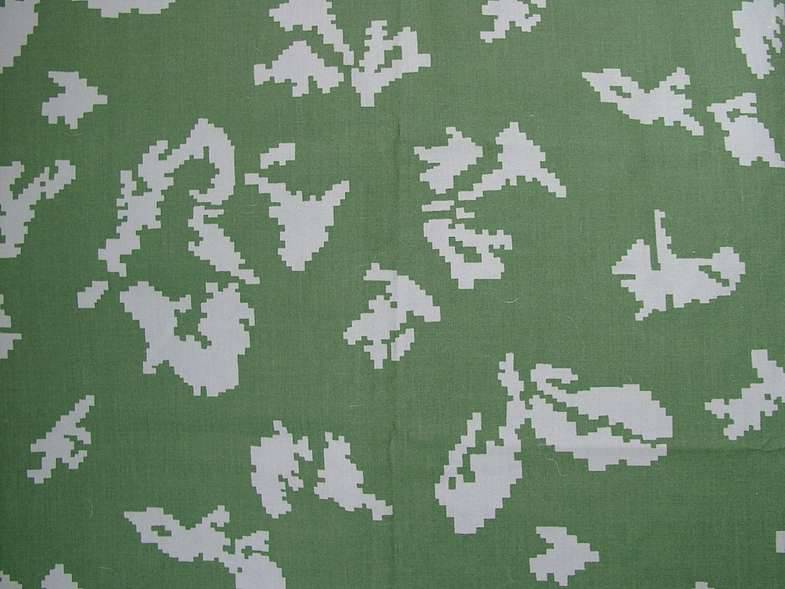
Fig. 3. Coloring arr. 1957 (KZS), option "Silver leaf"
This color exists in two versions while maintaining the same texture scheme: in one of the options, small spots have a gray-silver color, in the other (it was he who consisted in border troops) - sand or khaki. The background color of both options is olive, sometimes there are instances of marsh color. In any case, the background in this color scheme is always darker than spots. The spots themselves have an “angular” structure consisting of a set of squares.
It should be noted that this color scheme, although it is considered by some experts to be “obsolete”, performs both deforming and imitative functions quite well.
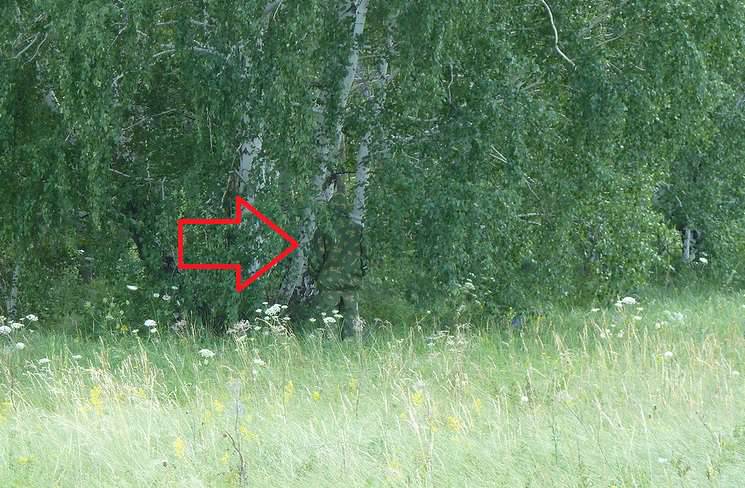
Fig. 4. Fighter in KZS on the ground
"Butane"
This camouflage was developed in the USSR in 1980-x as the main pattern for field uniforms. Despite the release of a significant number of products from it, it was not widely spread among the troops, although it was quite effective. Currently found in the VKS of the Russian Federation and in the Armed Forces of Ukraine (in Ukraine for a long time was the main camouflage), but in both cases it is actively removed from the supply, being replaced by other models.
Fig. 5. Camouflage "Bhutan"
Other names of this camouflage are "Oak" and "Ameba", and "Amoeba" is also called one of the camouflage of the Second World War times. The colors themselves can vary, only the scheme remains unchanged: a light green background, dark green spots and light brown amoebae intersecting ribbons.
In 1990-s in many parts of the Armed Forces of the Russian Federation there was a situation when officers wore “Bhutan”, and private and non-commissioned officers - HRV-93, therefore in 1990-s this camouflage was sometimes called “officer”.
HRV-93
Developed at the beginning of 1990-x, adopted for supply in 1993, replaced the ubiquitous "Afghan" khaki. When creating this camouflage, the experience of camouflage from the time of WWII, in particular, a number of German camouflage, was taken into account.
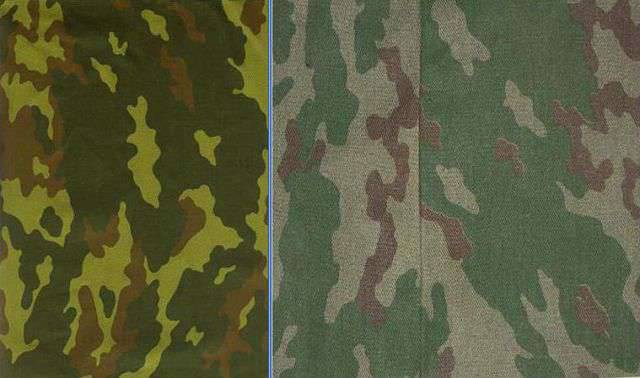
Fig. 6. HRV-93
Very often informally referred to as "Birch", as well as GLC. It was believed that the semi-official name of the HRV-93 is “Barvikha”, but this name is not found in official documents. Also sometimes referred to as “Watermelon” (or “Vertical Watermelon”), however “Watermelon” is also applied to HRV-98.
According to reviews of those wearing the shape of this color, it is “very good to lie” in it, because longitudinal spots very effectively imitate grass vegetation. However, according to experts, camouflage has a very narrow “sharpening”, is not universal and is applicable to any terrain. In addition, there is information that this type of coloring "created an unsightly appearance of servicemen at parades," therefore in 1998, the products of this color were removed from the supply.
HRV-98 Flora
Adopted for the supply of the Armed Forces of the Russian Federation as the main in 1998, came to replace the HRV-93. When developing this camouflage, the results of the study of the dynamic effectiveness of camouflage were taken into account, that is, the camouflage properties do not lose their functions when the object is moving. In accordance with the study, horizontal stripes contribute to the preservation of masking functions when the object moves, while the vertical stripes, on the contrary, unmask when moving.
Unlike previous camouflage, the HRV-98 has not only a digital code, but also the official name Flora, but unofficially, like the HRV-93, it was called the Watermelon or Horizontal Watermelon in the army.
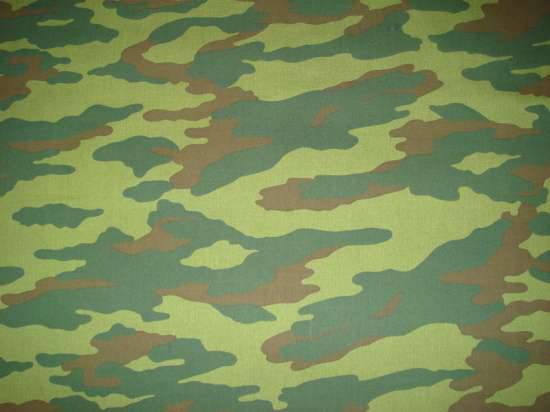
Fig. 7. HRV-98 Flora
There is a “Flora” color scheme in which the background is not light green, but dark yellow, sandy or khaki. Such color schemes were popular in the troops of the North Caucasus Federal District, where the grass burns out in June and, accordingly, all summer retains a yellowish tint. Officially, Flora was withdrawn from supply in 2009 (according to other data, in 2011), giving way to a more modern color scheme.
EMP / ZDU / Ruspat / Russian number / Russian pixel
This camouflage appeared in the 2008 year (it was accepted for supply a year later), after a fundamental decision was made to change Flora. Initially it was assumed that, since Flora roughly corresponds to the American Woodland, which in the US Armed Forces is actively changing to digital camouflage (see below), then the RF Armed Forces should keep up with this process. The creation of EMP was actively influenced by the German camouflage "Flektarn", the developers of which managed to "combine the incompatible": small spots that perform the simulation function, in this color scheme are combined so that they constitute groups of large spots that perform a deforming function. The EMP developers also took the same path, taking into account the results of studies that showed the effectiveness of extremely small (“pixel”) spots as constituent elements of a texture pattern (see derivatives from Marpat). As a result, EMP appeared.
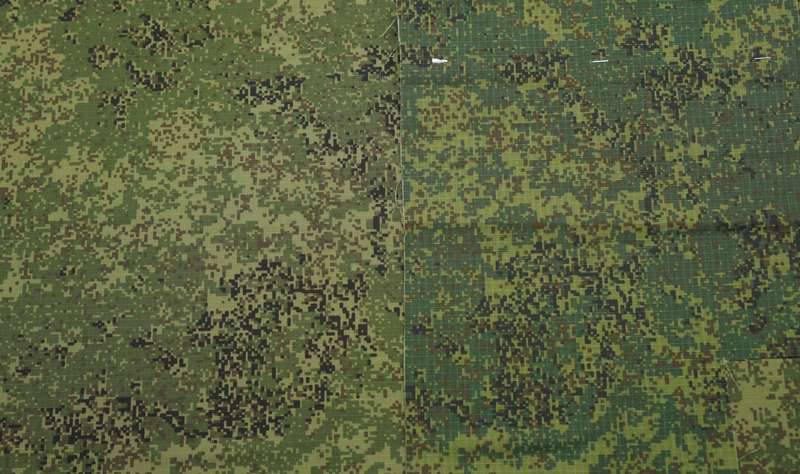
Fig. 8. EMP in two colors
The name “EMP” stands for “Single camouflage coloring” - it is under this name that this camouflage consists of the supply of the Armed Forces of the Russian Federation. However, it is known that the first manufacturer of products with this color gave her the name "ZDU" - "protection to the stop". In the West, this camouflage is known as "Ruspat" (Russian Pattern), by analogy with the American patis. Also unofficially, this camouflage is called “Russian numeral”, “Russian pixel” or (in military use) simply “Pixel”.
Currently, EMP is the main camouflage, consisting on the supply of the Armed Forces. Interestingly, it also consists of supplies in the Armed Forces of Belarus, but it is believed that the Belarusian version of the EMP has a slightly different color scheme.
"Undergrowth"
Created at the beginning of the 1990-ies in St. Petersburg NPO "Specmaterialy" as an alternative to HRV-93 for taking on the supply of the Ministry of Internal Affairs. When creating it, the same principles as in BCP-93 are observed, however, the vertical stripes are made more angular, the brown color is replaced with black, and the base is made lighter than in BCP-93. When creating the "Underwood" it was taken into account that the vertical stripes visually increase the height of a person in such camouflage, which is relevant for the Ministry of Internal Affairs, since the employee in this form has an additional psychological effect on the detained.
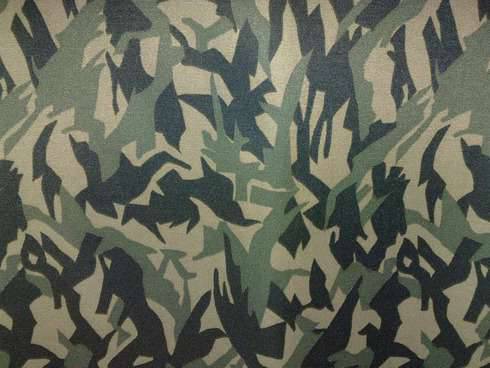
Fig. 9. "Undergrowth"
Officially he was on the supply of the Ministry of Internal Affairs, was actively used by various units of special operations.
"Raster undergrowth" / "Raster"
Created all in the same NPO "Special Materials." It is the first in the practice of creating camouflage colors "dual-frequency" camouflage. The fact is that the original "Underwood" had a good imitational, but rather weak deforming effect, and therefore, when creating its improved version ("Raster"), the original "Underwood" as it were imposed a specially twisted brown cellular network - it turned out to be "double camouflage or camouflage on camouflage.
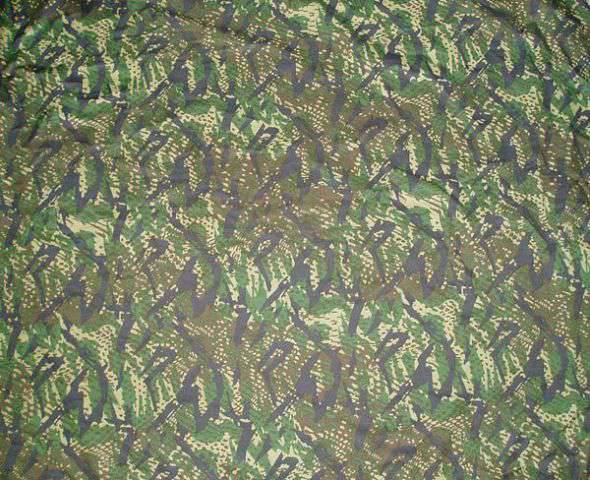
Figure 10. "Raster undergrowth"
As a result, the original drawing of the “Undergrowth” is perceived by the eye as if on the same frequency, and the superimposed “raster” network - on the other, which makes it impossible for an intuitive person to perceive a person in such camouflage as a complete object. There is even a common rumor that if you just walk down the street in Rastra, you will not attract anybody’s attention - the gaze of passersby will simply slide past. Americans later used this find of the specialists of “Special Materials” when creating the “Cryptek” camouflage series, but more on that below.
Another name “Rastra” is “Pheasant”, but it is used for products produced in this color not by NPO “Spetsmaterialy”, but by other manufacturers. Raster camouflage also officially consists of the supply of the Ministry of Internal Affairs. For some reason, however, not widespread.
"Tiger" / "Reed"
Strictly speaking, this camouflage, although produced in Russia on an industrial scale by various companies and, moreover, is widely used in various power structures, is not a Russian development - it is rather an “adaptation” of the existing foreign camouflage (originally Malaysian commercial Tiger Stripe) to Russian conditions.
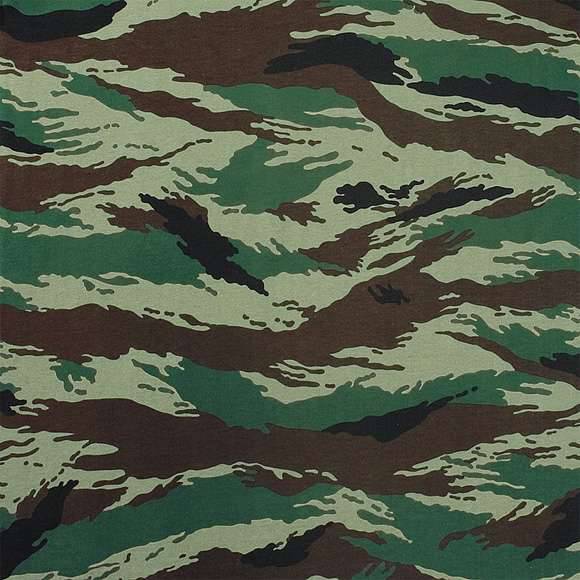
Fig. 11. Camouflage "Tiger" one of the Russian options
The color scheme, traditionally for Russian camouflage, can be changed by turning a light green base into sand or khaki.
If the "Tiger" was the result of a conscious reworking of the existing foreign analog, the "Reed" appeared due to chance, when the manufacturer mistakenly sewed the form so that the "Tiger" strips turned out to be vertically positioned. However, the classic "Tiger" is often referred to as "Reed."
Officially never been on the supply, unofficially - is used by all security forces, although now its popularity is falling due to the appearance of more efficient colors.
"Partizan"
Commercial camouflage, officially not consisting anywhere on the supply. Unofficially, it is very popular, especially in the North Caucasus Federal District, where its yellow-brown deforming stripes are very relevant against the background of grass that has been burned out for much of the warm season. Created under the influence of the German camouflage of WWII (almost exactly one of them copies), this is why Partizan is called - because, as far as we know, its creators were originally, without particularly bothering with the name, they planned to call it SS camouflage ".
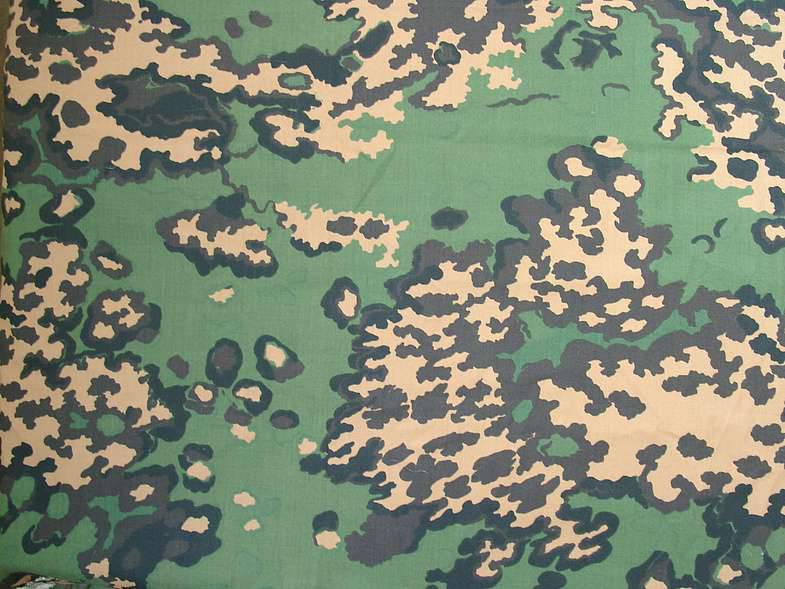
Fig. 12. Camouflage "Guerrilla"
In the European part of Russia, this camouflage is very effective in August-September. The rest of the time it has an excellent deforming, but controversial imitative function.
"Break" / "Skol"
Another commercial camouflage, unofficially on the supply is not made up, but is very actively used in various power structures. It is known that a number of parts (not subunits, namely, parts) of SPN, both army and explosives, prefer the shape of this particular color.
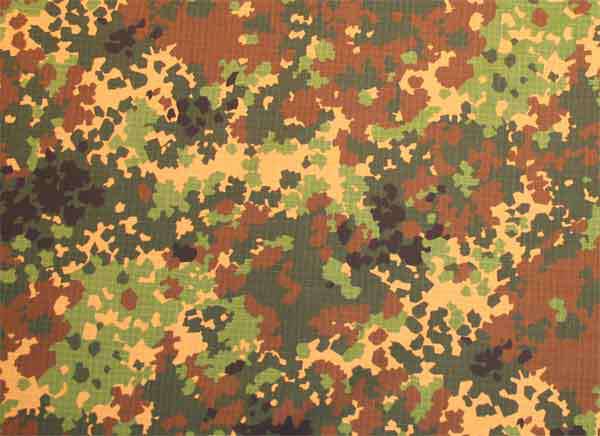
Figure 13. Camouflage "Break"
During the creation of the Kink, Flektarn’s experience was used, as in the case of EMP. Interestingly, the "Kink" has such a specific location and color combination of spots that create the illusion of three-dimensional smooth fabric, and, accordingly, has a very good deformation effect. Unlike most Russian camouflage, "Kink" does not allow the use of other than the original, colors.
As with the Partizan, it is believed that this camouflage is effective mainly in August and September.
Surpat
Developed by the Russian company "Survival Corps" by request of employees of special purpose units. It is an adaptation of the American "pattern" scheme under Russian conditions.
Fig. 14. Surpat
Unlike the original (American “patterned” camouflage) Surpat uses a light gray color as the base; the location of spots is changed; brown and green are as close as possible to the color scheme characteristic of the Russian landscape. Despite this, it is notable for its great versatility with respect to the terrain — tests conducted by Survival Corps itself showed Surpath's performance in almost any natural area.
There is no official information on the use of Surpat in any units of the Armed Forces and the Ministry of Internal Affairs of the Russian Federation, but sometimes on documentary materials you can see soldiers in this camouflage.
Spektr
Another adaptation of the "patterns" under Russian conditions. It has a somewhat lower versatility compared to Surpath, however, in comparison with it, it is somewhat better imitative action in a forest landscape.
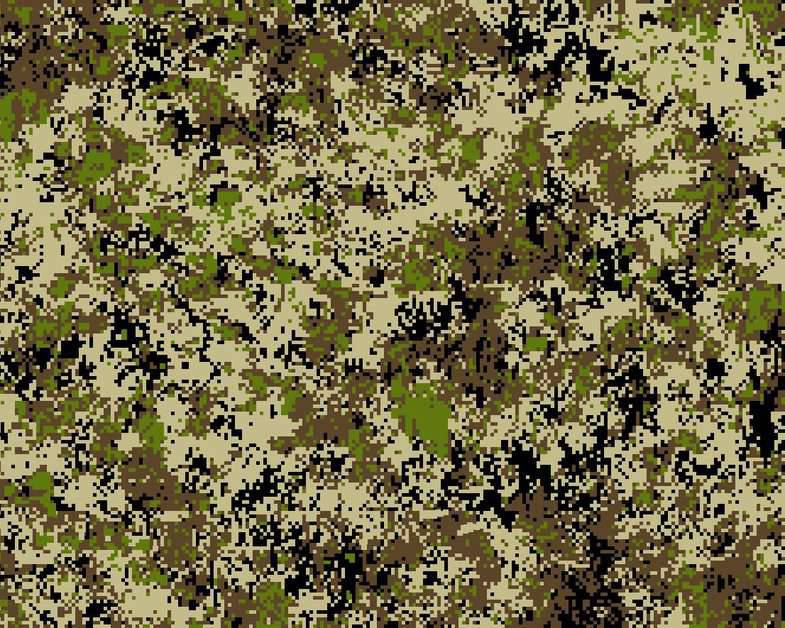
Fig. 15. Spectrum
There is also a variant of "Spectrum-NCFD", where the color gamut is adjusted in the direction of "yellowness". Unlike Surpat, it is widely produced by several manufacturers. Interestingly, it was “Spectrum” that was personally used by I. Strelkov and his division.
Twilight
Originally created as a hunting, exclusively commercial camouflage. Like most hunting camouflages, it was designed for very narrow conditions: a rocky surface with moss growths, morning and evening hours of the day. However, it turned out unexpectedly that this camouflage shows itself quite well in a much wider range of conditions than those under which it was created, which is why it has become very widespread.
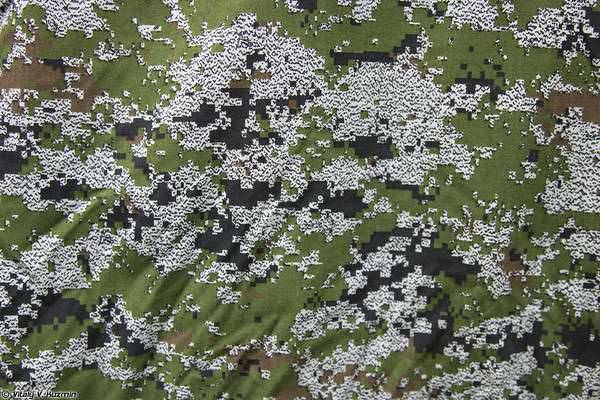
Figure 16. Dusk
Officially, there is no supply anywhere, but it is informally used by some departments and individual employees. Russian companies also produce a wide range of Western-designed camouflages, but they will be discussed in the sections of the countries where they were created.
The next part of the material will be devoted to the consideration of camouflage Anglo-Saxon countries.
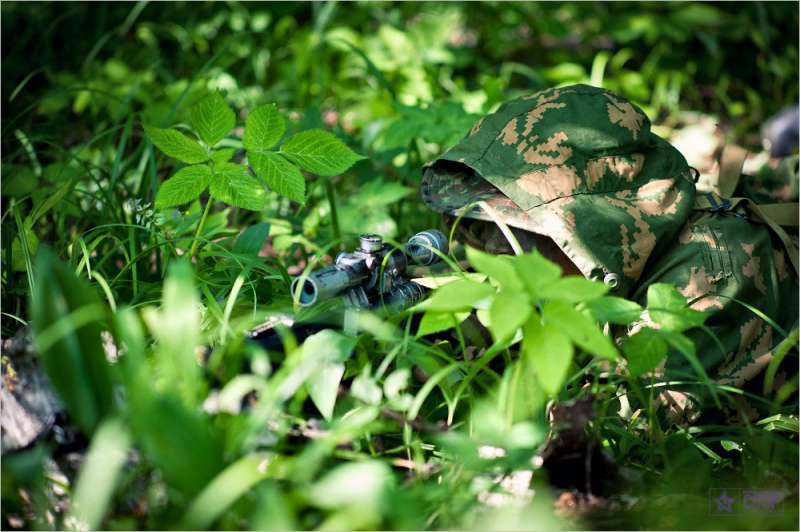
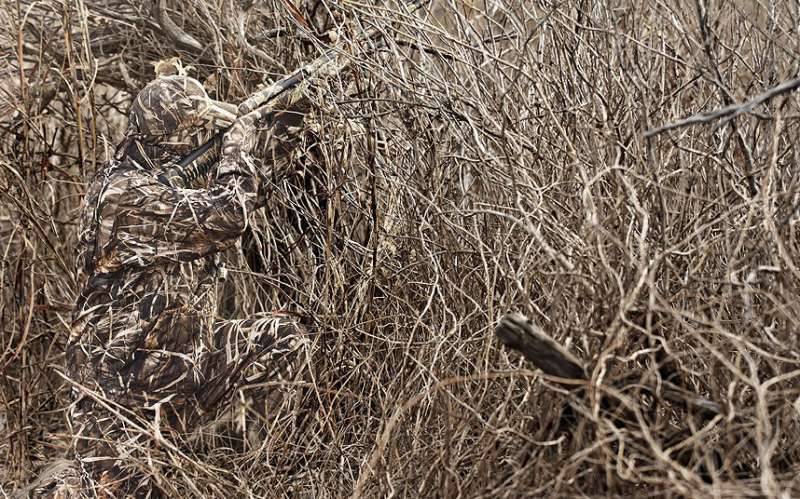
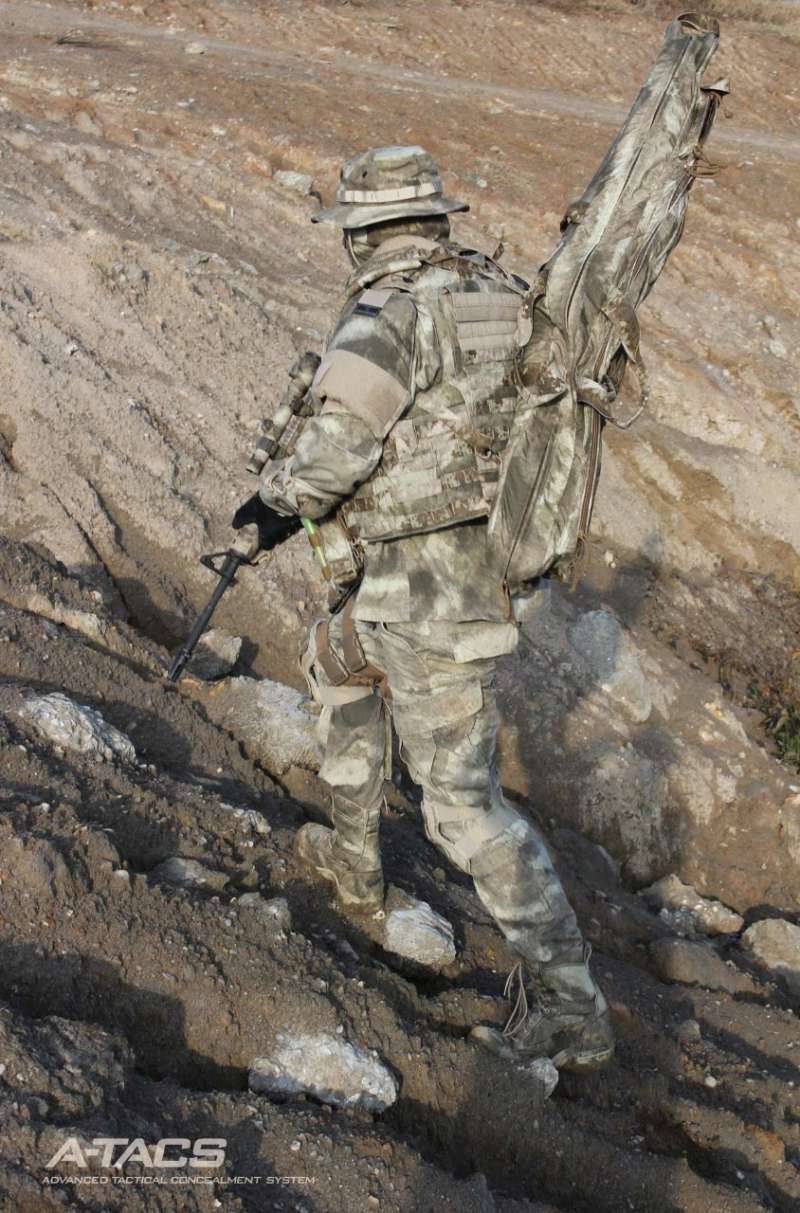
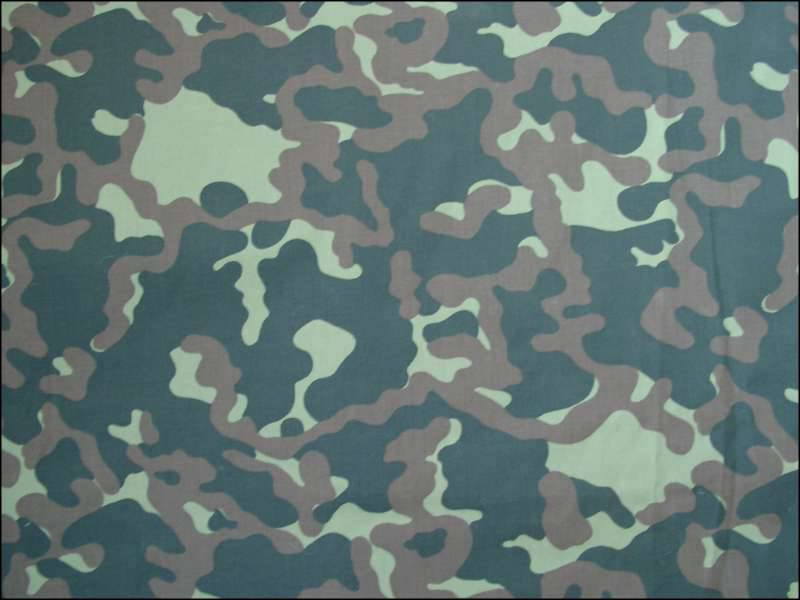
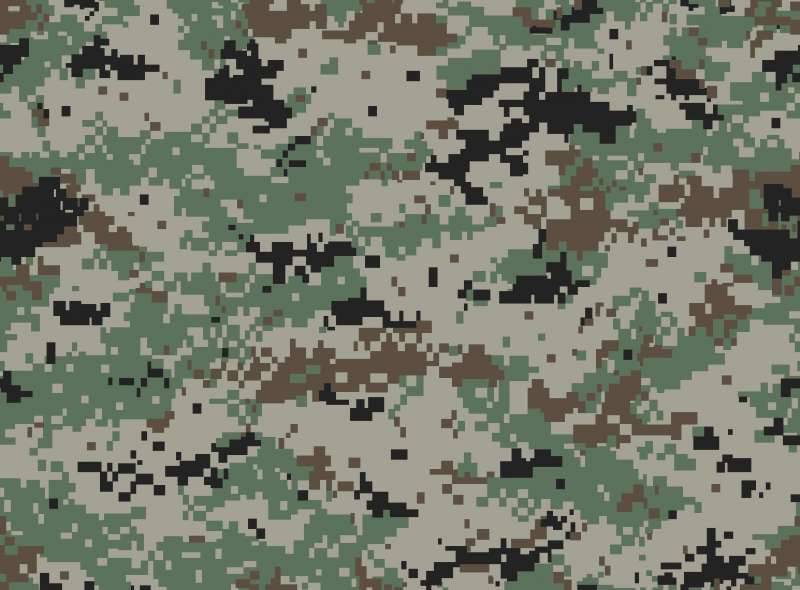
Information